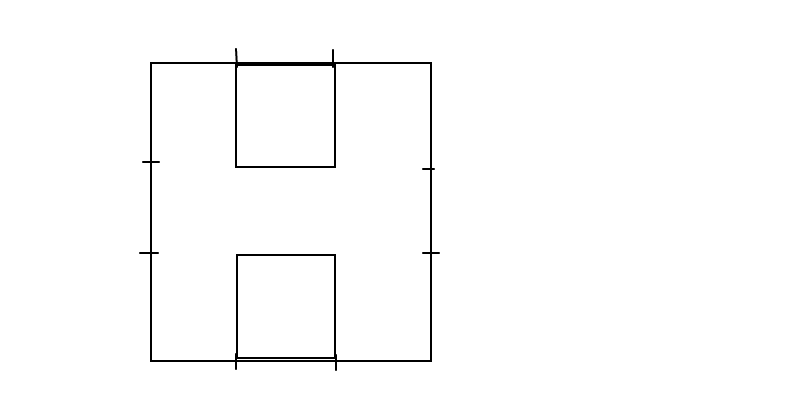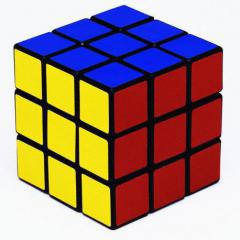-
Posts
53 -
Joined
-
Last visited
-
Days Won
1
Content Type
Profiles
Forums
Events
Gallery
Blogs
Posts posted by Buddyboy3000
-
-
Spoiler
First, remove the bottom left match on the 6, and then move it to the top of the 1 so it becomes a 7. Now the equation will say 5+7=12, which is true.
-
Spoiler
My answer is choice B. This is because the numbers in the grid have a pattern within the horizontal rows. This pattern is that the last two numbers in the row are equal to the previous two numbers added together.
6 9 15 24 6+9=15 9+15=24
2 4 6 10 2+4=6 4+6=10
11 19 30 49 11+19=30 19+30=49
7 1 8 9 7+1=8 1+8=9
This pattern works with answer choice B throughout the grid of numbers, so that is my final answer.
-
These are my guesses:
SpoilerFirst Sequence: 31
This is because I think there are two separate patterns in the sequence, with the even and odd terms. So, there is 43, 38, 34, ? and 8, 9, 11, 14. For the second sequence inside this one, you add 1, then 2, and then 3, to get the numbers in the sequence. For the first sequence now, you subtract 5, and then 4, so I guess the next time it will be by 3. This gets 34-3, which is 31.
Second sequence: 61
I thought 61, because I noticed the pattern that each term added by the last two gets the next term. For example, 0+2+3=5, 2+3+5=10, 3+5+10=18, 5+10+18=33. So, 10+18+33 equals 61. To check this, 18+33+61 equals 112, which is the last term in the sequence.
-
Using the same method that BobbyGo took, my number would be a...
Spoiler...1/googolplexianth. A googolplexianth is a one followed by a googolplexian of zeros. This number can also be written out as 10^10^10^10^10^10. So, the smallest positive number I can pick is (1/googolplexianth).
-
Spoiler
Technically, there are an infinite amount of solutions for this equation. To find a solution, you can plug any value for the integer "a" to get a value for x and y.
If "a" is any integer greater than 1, then the the solution is:
x=a-1sqrt(a)
y=a-1sqrt(a^a)
Examples: a=1.5 x=2.25 y=3.375 2.25^3.375 = 3.375^2.25 = 15.43888...
a=2 x=2 y=4 2^4 = 4^2 = 16
a=3 x=sqrt(3) y=sqrt(27) sqrt(3)^sqrt(27) = sqrt(27)^sqrt(3) = 17.36190...
a=4 x=3sqrt(4) y=3sqrt(256) 3sqrt(4)^3sqrt(256) = 3sqrt(256)^3sqrt(4) = 18.80532...
-
Spoiler
I'm not too sure if this is right, but I got two possible solutions:
y=3^(log(x)/log(2))
and
y=-3^(log(-x)/log(2))
I got these two solutions by trying to make an equation where the y-value triples only when the x-value doubles, and not after each x-value.
-
I think I got what the answer is, now that we know it is 1/(2x).
SpoilerSince x is in the denominator, the answer will depend on what x is. This means the answer I got was an equation.
If y is the amount of years ago, then the answer is: y=(-30 log(2x^2))/log(2)
-
Spoiler
I did the same thing araver did the second time, and found the fraction of the circle subtracted by the triangle. For this, I only needed to look at the intersection between two of the circles.
First, I found the triangle made by the circle's center and the two points of intersection. This triangle has side lengths of 1, 1, and 2sqrt(2/3). Next, the area of this circle is sqrt(2)/3. Then, I solved for the angle connecting to the center, which is sec(-1/3). Now, I can use that to find the fraction of the circle, which is sec(-1/3)*pi/360. Subtracting that by sqrt(2)/3 gets us half of the intersection, which is about 0.48. Multiply that by 6 to get the area of the whole yellow section, which is approximately 2.90347.
-
Oh, maximum. Sorry, I didn't catch that.
SpoilerFor a maximum, I got 14 total squares touched. Also, I put the points like (row, column).
(1,1)(2,3)
(4,2)
(2,1)
(3,3)
(1,2)
(3,1)
(4,3)
(2,4)
(3,2)
(1.3)
(3,4)
(2,2)
(4,1)
-
Spoiler
One way to think about it is to treat the crystal like a pyramid, with some exceptions.
To find the amount of dots on the bottom I did: (l)(h+1)/2 This is like the normal equation except adding the length again makes up for the part of the atoms that are cut off in the straight line. For 1 million, I got (1,000,000)(1,000,001)/2 = 500,000,500,000
With the number of atoms on the bottom, next find the equation to get the answer which is (b)(h+2)/3. Again, the h+2 is to make up for what is cut off. I would include the proof for that but is a bit complicated to explain.

So, the answer is 500,000,500,000*1,000,002/3 = 166,667,166,667,000,000.
This is the same answer Pickett got, so he got the right answer first.
-
Spoiler
I got it to go from A to B in 5 moves (6 squares touched).
(1,1)
(2,3)
(4,2)
(3,4)
(2,2)
(4,1)
-
Also, the back side of the throne is not real. Once you look at it close enough, it is actually part of the painting.
-
SpoilerOn 3/8/2017 at 6:51 AM, Dreaming said:
There are originally five white goats and seven black goats. Then a tiger eats two goats of each color. After the tiger has eaten, what is the multiplication or product of the number of white and black goat?
According to this, it only says, "the multiplication or product of the number of white and black goat" If it is just one white goat and one black goat, then the answer is one. However, it could just be a spelling error, and the answer is something else.
-
Spoiler
You can also have one big square with two smaller squares:
Each tick mark separates each matchstick

-
Sorry, accidentally posted it twice. Probably because the website went down at that time.

-
I believe I did the equations correctly...
SpoilerFirst equation: Numbers: 851, 1998, 9512
Forwards: 851 + 8661 = 9512 Backwards: 158 + 1998 + 2156
Second equation: Numbers: 1091, 1501, 2652
Forwards: 1091 + 1501 = 2592 Backwards: 1601 + 1051 = 2652
Third equation: Numbers: 1101, 1181, 2822
Forwards: 1101 + 1181 = 2282 Backwards: 1011 + 1811 = 2822
Fourth equation: Numbers: 1801, 1901, 2982
Forwards: 1081 + 1901 = 2982 Backwards: 1801 + 1061 = 2862
I believe I did the equations correctly...
SpoilerFirst equation: Numbers: 851, 1998, 9512
Forwards: 851 + 8661 = 9512 Backwards: 158 + 1998 + 2156
Second equation: Numbers: 1091, 1501, 2652
Forwards: 1091 + 1501 = 2592 Backwards: 1601 + 1051 = 2652
Third equation: Numbers: 1101, 1181, 2822
Forwards: 1101 + 1181 = 2282 Backwards: 1011 + 1811 = 2822
Fourth equation: Numbers: 1801, 1901, 2982
Forwards: 1081 + 1901 = 2982 Backwards: 1801 + 1061 = 2862
-
I think I got the right answer
Spoiler1st weigh: (9U to 9U) with 12 coins leftover (12U) U = unknown coin
If equal, the fake coin is in the group of 12 leftover coins (go to A) N = normal coin
If uneven, we have 9H and 9L (go to B) H = possibly heavier fake coin
2nd weigh: A: (9U to 9N) with 3 coins leftover (3U) L = possibly lighter fake coin
If equal, then the fake coin is the the 3 leftover (3U) (go to C)
If the unknown side is heavier, it is in 9H (go to A)
If the unknown side is lighter, it is in 9L (go to B)
B: (9H to 9N) with 9L leftover
If the possibly heavier coins are heavier, the fake coin is in 9H (go to A)
If the possibly heavier coins are not heavier, it is in 9L (go to B)
3rd weigh: A: (3H to 3H) with 3H leftover
If one side if heavier, the fake coin is in that 3H (go to A)
If both sides are equal, then it is in the 3H leftover (go to A)
B: (3L to 3L) with 3L leftover
If one side is lighter, the fake coin is in that 3L (go to B)
If both sides are equal, it is in the 3L leftover (go to B)
C: (3U to 3N) with none leftover
If the unknown side is heavier, then the fake coin is in 3H (go to A)
If the unknown side is lighter, then it is in 3L (go to B)
4th weigh: A: (1H to 1H) with 1H leftover
If one side is heavier, that side is the fake coin
If both sides are equal, the leftover coin is the fake coin
B: (1L to 1L) with 1L leftover
If one side is lighter, that side is the fake coin
If both sides are equal, the leftover coin is the fake coin
-
@FUZZY Does the 1000 years start after your children has two children, or from when the question starts?
-
Spoiler
The family was able to go on the picnic.
3 hours ago, FUZZY said:A certain day was yesterday when the day before yesterday was yesterday . On that certain day Kim's parents said "we'll go on a picnic the day after tomorrow if it doesn't rain". It rained the day before yesterday but not since.
Did the family go on the picnic?When it says the certain day was yesterday, and the day before yesterday is yesterday, they are equal to each other. You are only confused by all the words. So, the certain day is the day before yesterday, which is two days ago. Then, the family will go on the picnic the day after tomorrow from the certain day. The family will go on the picnic today. If it rained the day before yesterday, then the family will be able to go on the picnic today.
-
@Thalia I am still working on it. It is coming along, but just very slowly. Also, school is giving me a bit less time to do it.
-
One question did come up to me, because something does not add up.
106 says do-wop and grunge are listened to in the fifth or sixth house. 157 says that the house opposite of house 5 listens to metal, which would be the sixth house. These say that the sixth house listens to two types of music.
-
The way I learned to do grid puzzles was to make a grid with every variable by every variable. The two scroll bars were for the width and height. There seems to be another way to do this to make it smaller. If any of you could give some insight on how to do this correctly, it would be great.
-
My trouble is the same as Thalia's, because my spreadsheet is huge. I have never had one before that has a scroll bar on each side.
However, I am still working on the puzzle, slowly but surely. My questions have already been answered, so this is all for now.
-
I was able to find out one part of this question
SpoilerThe product of the 4 squares has to be 27000.
I find this out by first multiplying all of the numbers together, which is 531441000000000000. Next, because there are 16 numbers, I found the 16th root of it, which is about 12.82. Then, because you multiply four of the numbers together, I put that to the fourth power. This got me the answer of 27000. This can be simplified to the product of all of the numbers, 531441000000000000, to the fourth root to make 27000.
However, I have not been able to find the arrangement of the numbers in the four by four grid.


Cubicle Stack
in New Logic/Math Puzzles
Posted
I got 26 possibilities.
My answer is the same answer that Thalia got, but instead of four edge to edge possibilities, there are five. Other than that, everything else is the same.